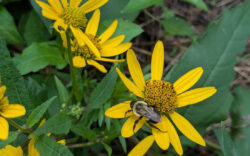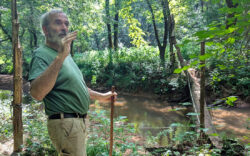The UGA Herbarium feels like a library. With its neatly organized, color-coded stacks of folders, buckets of archival glue and silently rolling shelves, the place gives that impression. Our local herbarium also connects to a teaching classroom and a lab for DNA testing. With more than a quarter million specimens, the herbarium is a place for experienced researchers, as well as beginners, to learn more about kingdom plantae.
“[The herbarium] is a collection of pressed and dried plants,” said Steven Hughes, collection manager. “It’s a genetic repository for people to get information from.”
The herbarium doesn’t just stock one specimen. Take the eastern red cedar (Juniperus virginiana), the tree currently billowing dust storms of pollen into the air. There are 275 different samples of the eastern red cedar available for study. You can find the digital collection here, or you can visit the Global Information Biodiversity Facility at gfib.org and search “University of Georgia.”
Such a large collection across different states and decades helps scientists assess the plasticity of a species. Plasticity describes how an organism changes its physical features to adapt to different environments. Collecting many specimens of the same plant in different locations also helps track if the population is growing, shrinking, moving or changing its flowering time, Hughes said.
The records themselves look like Mother Nature went with scrapbooking as her new favorite hobby. Each specimen is flattened and dried. The sample is carefully glued down, along with information about where and when it was collected. Additional notes about the person who collected it or what time the plant flowered can be included as well. Sometimes, small envelopes are added to the page to enclose particularly delicate structures, such as small, fluffy seeds.
Tanisha Williams, a professor of plant biology and curator of the herbarium, used herbarium records to show the South African-native common geranium (Pelargonium) blooms five days earlier than it did a century ago. Williams completed this research as part of finishing her doctorate in ecology and evolutionary at the University of Connecticut. She looked at many geranium specimens across national and international herbariums. “We needed several thousand records to pick up that five days,” Williams said.
The Athens herbarium does focus more on plants growing in the Southeast than other areas. “Generally speaking, the bias is towards locality,” Hughes said. Whether a plant is native or invasive doesn’t matter much. If it grows in Georgia, it’s fair game for the herbarium. Weeds also get collected and preserved for posterity. Some cultivated plants are kept in the records as well, but they are marked as such.
One of the many functions of an herbarium is helping identify new species. While this doesn’t happen often, it’s necessary to search through recorded specimens to make sure a particular plant hasn’t yet been documented.
Recently, a researcher thought they’d found a cryptic Oxalis species, Hughes said. A cryptic is a species that looks the same, but is genetically different from the other species. This particular oxalis (also known as wood sorrel, and sometimes mistaken for clover because of the leaf shape) flowers at a different time than other samples. The herbarium allowed the scientist to check known records to test their theory. “It’s painstaking to determine,” Williams said.
But, if you’re like me, you’re not aiming for ground-breaking research—you just want to learn more about plants. Non-researchers can learn from the herbarium as well, though it’s not like a museum. “We don’t have things on display,” Hughes said.
“But people can still schedule tours with us,” Williams added.
Interested folks will need to make an appointment for a general tour. The herbarium hosts groups like the 4-H, Trees Atlanta and the Department of Natural Resources for fun and educational classes. Opportunities for public activities, like pressed plant art, are posted on the group’s Instagram @ugaherbarium.
I’ll be keeping an eye out for the public events myself. While a general tour gave me an idea about how the herbarium works, I’d love to take a botany class with these knowledgeable plant people.
Like what you just read? Support Flagpole by making a donation today. Every dollar you give helps fund our ongoing mission to provide Athens with quality, independent journalism.










